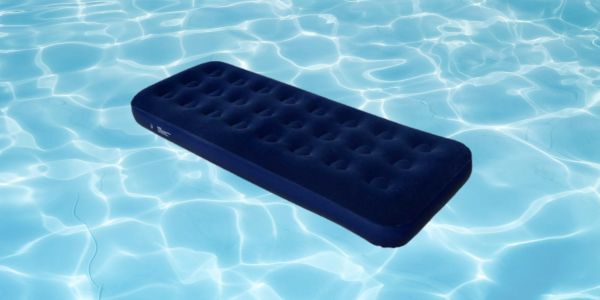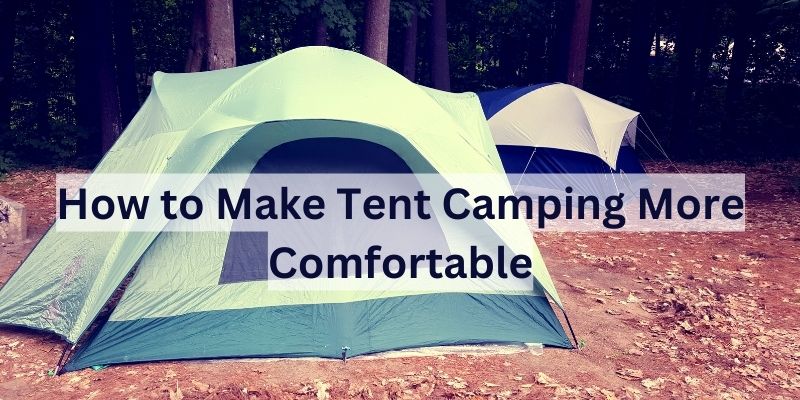Tent camping is a popular outdoor activity that allows you to reconnect with nature, unwind from the stresses of everyday life, and make memorable memories with family and friends. While roughing has an inherent appeal, making your tent camping experience more comfortable can considerably improve your enjoyment. After all, who wouldn’t want to wake up well-rested, well-fed, and ready to tackle a day of outdoor adventure?
Are you ready to embark on an incredible outdoor experience and want to Make Tent Camping More Comfortable? If you’re a fan of tent camping like me, you probably enjoy immersing yourself in nature, sleeping under the stars, and waking up to the sound of chirping birds. But let’s face it, sometimes roughing it can feel, well, rough. Fear not!
Choose the Right Tent
The first step toward a nice camping vacation is selecting the correct tent. Because your tent will be your shelter and refuge throughout your outdoor excursion, it is critical that you choose one that meets your requirements.

Evaluating Tent Size and Style
The size of your tent is critical since it defines how much living space you will have. If you’re camping with a group or family, a bigger tent may be necessary to accommodate everyone comfortably. Solo campers, on the other hand, may prefer a smaller, more compact tent.
The design of the tent is also important. Dome, cabin, and tunnel tents are among the different types available. Each type has benefits, so choose the one that best suits your requirements. Dome tents, for example, are simple to erect and durable in windy circumstances, while cabin tents provide ample headroom and are ideal for family camping.
Ventilation and Climate-Appropriate Tents
Ventilation is critical for preventing condensation and keeping your tent fresh. To guarantee proper ventilation, look for tents with several windows, vents, and mesh panels. Consider a tent with a rainfly that can be modified to provide ideal ventilation and protection.
Choose a tent that is suited for the climate in which you will be camping. Four-season tents are built for harsh weather and can be excessively hot in the summer, but three-season tents are adaptable and acceptable for the majority of camping trips.
Easy Setup and Quality Materials
In terms of comfort, setup time might be a game changer. Look for a tent that is simple to set up, especially if you are a novice. To ensure a stress-free vacation in the great outdoors, practice constructing your tent at home before your trip.
Quality materials are essential for long-term durability and comfort. Look for a rainfly made of tough materials, with strong zippers and a sturdy frame. A high-quality tent will last for many years, making it an excellent investment in your camping experience.
When it comes to making your tent camping more comfortable, selecting the right tent is crucial. Consider the size of your group and the amount of gear you’ll be bringing along. A tent that’s too small can feel cramped and uncomfortable, while a tent that’s too large may be difficult to manage.
Look for a tent with enough headroom to sit up comfortably and consider features like mesh windows and doors for proper ventilation. Additionally, a tent with a rainfly will provide extra protection during wet weather, keeping you dry and cozy inside. Take the time to research different tent options and read reviews to ensure you find the perfect fit for your camping needs.
Invest in a Good Sleeping Pad or Air Mattress
Sleeping on the hard ground might be unpleasant, so purchase a comfy sleeping pad or air mattress. These give padding and insulation, allowing you to sleep peacefully.

Sleeping on the hard ground can leave you waking up with aches and pains. That’s why investing in a quality sleeping pad or air mattress is essential for a comfortable night’s sleep. Sleeping pads come in various thicknesses and materials, such as foam or inflatable options. Choose one that offers sufficient cushioning and insulation, especially if you’ll be camping in colder climates.
Air mattresses, on the other hand, provide a more bed-like experience and can be inflated to your desired level of firmness. Whichever option you choose, prioritize comfort and portability. Look for lightweight and compact designs that are easy to pack and inflate. Your back will thank you for it!
Upgrade Your Sleeping Bag

A cozy and warm sleeping bag is a game-changer when it comes to camping comfort. The right sleeping bag should keep you snug and comfortable throughout the night. Consider the temperature rating of the bag, which indicates the lowest temperature at which it will keep you warm. If you’re camping in colder conditions, opt for a bag with a lower temperature rating.
Look for features like a hood to keep your head warm and zippered vents for temperature regulation on warmer nights. Synthetic insulation is a good choice if you anticipate camping in wet conditions since it retains heat even when damp. Down insulation, on the other hand, provides an excellent warmth-to-weight ratio and compressibility. Choose a sleeping bag that suits your camping needs and matches the climate you’ll be in.
Create a Soft Base

Setting up your tent on uneven or rocky ground can lead to discomfort while sleeping. To ensure a more comfortable sleeping surface, take the time to clear the ground of rocks, twigs, and other debris before pitching your tent. This will help prevent any sharp objects from poking through the tent floor and causing discomfort.
Adding a groundsheet or tarp underneath your tent provides an extra layer of protection against moisture and increases overall comfort. It acts as a barrier between you and the ground, providing additional insulation and preventing cold or dampness from seeping into your sleeping area. Make sure the groundsheet is slightly smaller than your tent footprint to prevent rainwater from collecting between the tent and the groundsheet.
Bring Pillows and Blankets

Sleeping bags, while cozy, may not provide the same level of comfort as your bed at home. That’s where pillows and blankets come in to enhance your sleeping experience. Pack pillows that offer proper neck support and help align your spine for a more comfortable night’s sleep.
You can bring regular pillows from home or opt for camping-specific pillows that are designed to be lightweight and packable. Additionally, consider bringing extra blankets or sleeping bag liners to layer for warmth during colder nights. Having the ability to adjust the number of blankets or their thickness allows you to personalize your sleeping setup for optimal comfort.
Organize Your Gear
Keeping your tent neat and organized not only maximizes space but also contributes to a more comfortable camping experience. Clutter inside the tent can make it feel cramped and create obstacles when moving around. Utilize the storage pockets or hanging organizers built into your tent to keep essential items within easy reach.
This will save you from rummaging through bags and potentially disturbing your fellow campers in the process. Organizing your gear also helps create a peaceful and relaxing environment, allowing you to fully enjoy your time spent inside the tent. Take a few extra minutes each day to tidy up and maintain a clutter-free space.
Lighting and Ambiance

Proper lighting can make a world of difference in creating a cozy and comfortable atmosphere inside your tent. Battery-powered lanterns or string lights are excellent options for providing ample illumination. Lanterns can be hung from the tent ceiling or placed on a nearby surface to distribute light evenly.
String lights, on the other hand, add a touch of ambiance and can be draped along the tent walls or ceiling to create a warm and inviting glow. Opt for soft white or warm yellow lights to avoid harsh brightness that may disturb your sleep. Dimmer switches or lanterns with adjustable brightness settings are great for creating the perfect ambiance at night. With the right lighting, you can relax, read a book, or play games comfortably inside your tent.
Comfort During Tent Camping
| Category | Comfort Tips |
|---|---|
| Tent Selection | Choose the right size and style for your needs |
| Opt for good ventilation and climate-appropriate tents | |
| Select a tent that’s easy to set up and made of quality materials | |
| Campsite Selection | Consider location, terrain, and noise levels |
| Sleeping Gear | Choose a sleeping bag appropriate for the weather |
| Invest in a comfortable sleeping pad or air mattress | |
| Bring quality pillows and blankets | |
| Campsite Setup and Organization | Set up a camp kitchen and dining area |
| Keep your tent organized and well-stocked | |
| Ensure proper campsite lighting for safety | |
| Meal Planning and Cooking | Plan easy and delicious camp meals in advance |
| Bring essential cooking equipment and utensils | |
| Practice leave-no-trace cooking and clean-up | |
| Clothing and Personal Comfort | Dress in layers and prepare for the changing weather |
| Dress in layers and prepare for the changing weather | |
| Maintain personal hygiene with portable shower options | |
| Campfire and Entertainment | Follow safe campfire practices and enjoy campfire cooking |
| Bring entertainment options like books, games, and stargazing | |
| Engage with nature through birdwatching and wildlife tracking | |
| Insect and Wildlife Management | Strategies to avoid and deal with insects |
| Safely coexist with wildlife and practice proper food storage | |
| Dispose of waste responsibly to avoid attracting wildlife | |
| Weather Preparedness | Monitor weather conditions and forecasts |
| Prepare for rain, wind, and temperature fluctuations | |
| Have an emergency plan and essential safety measures in place | |
| Leave No Trace Principles | Understand the importance of responsible camping |
| Follow principles for minimizing environmental impact | |
| Pack out what you pack in and leave no trace |
Campsite Selection
The location of your campground has a big influence on your camping experience. Consider the following elements while selecting your campground to enhance comfort.

Choosing the right campsite can significantly impact your comfort level while tent camping. Look for level ground that is free from rocks, roots, and other obstructions that may cause discomfort under your tent or sleeping area. Clear away any debris or sharp objects before setting up your tent to ensure a smooth and comfortable surface. Consider factors like shade, proximity to water sources which leads to mosquitoes while camping, and privacy when selecting your campsite.
Shade helps keep the tent cooler during hot summer days while being close to water sources allows for easy access to hydration and cleaning. Privacy can enhance your overall camping experience by reducing noise and providing a sense of seclusion. Take your time to explore different campsites within the area and choose the one that suits your preferences for a more comfortable stay.
Stay Dry
Staying dry is essential for a comfortable tent camping experience. Moisture inside the tent can lead to discomfort, condensation, and a generally unpleasant environment. To keep your tent dry, ensure that you have a rainfly securely attached to the tent. The rainfly acts as a protective barrier against rain and prevents water from seeping through the tent walls. Make sure it extends over the entire tent, leaving no gaps where water could enter.
Proper ventilation is also crucial to reduce condensation. Open windows and vents as needed to allow air to circulate, preventing excess moisture buildup inside the tent camping making it more comfortable. During wet weather, avoid touching the tent walls from the inside, as it can cause water to leak through the fabric. Additionally, keep wet items outside the tent or in a designated vestibule area to prevent dampness from spreading.
Don’t Forget Comfort Items

Finally, don’t underestimate the power of personal comfort items to make your tent camping experience more enjoyable. Pack a few items that make you feel at home and help create a cozy atmosphere. For some, it may be a favorite book or a portable camping chair for lounging around the campsite.
Others might enjoy the gentle sway of a hammock between two trees, providing the perfect spot for relaxation and taking in scenic views. These small touches can make a big difference in your overall comfort and enjoyment during the camping trip. Consider your personal preferences and bring along a few comfort items that resonate with you. After all, camping is about finding that perfect balance between immersing yourself in nature and indulging in the comforts that make you feel at ease.
What Comforts Should You Bring When Tent Camping?
When tent camping, it’s important to bring along comforts that make your outdoor experience more enjoyable and cozy. Here are some comfort items you should consider packing:
- Pillows: Bring comfortable pillows that provide proper neck support and enhance your sleeping comfort. You can opt for camping-specific pillows designed to be lightweight and packable or bring regular pillows from home.
- Camp Chairs: Portable camping chairs offer a comfortable seating option around the campsite. Look for lightweight, foldable chairs with padded seats and backrests for extra comfort. They are perfect for relaxing, enjoying meals, or sitting by the fire.
- Hammock: A portable camping hammock is a fantastic addition to your camping gear. It provides a cozy spot for lounging, reading, or taking a nap. Look for hammocks that are lightweight, easy to set up, and come with tree-friendly straps.
- Camp Table: Having a portable table makes meal preparation and dining more convenient. Look for lightweight, foldable tables that are easy to transport and provide a stable surface for cooking or enjoying meals.
- Lighting: Good lighting is essential for creating a cozy ambiance at your campsite. Bring battery-powered lanterns, string lights, or headlamps to illuminate your tent and outdoor area. Adjustable brightness settings and warm-colored lights can enhance the comfort and relaxation factor.
- Portable Speaker: If you enjoy listening to music or podcasts while camping, a portable Bluetooth speaker can add to the ambiance. Look for compact, durable speakers that are resistant to water and outdoor conditions.
- Personal Comfort Items: Bring along personal comfort items that make you feel at home, such as a favorite book, a journal, or a small portable game. These simple pleasures can add a touch of familiarity and relaxation to your camping experience.
Conclusion
Making Tent Camping More Comfortable is all about planning and bringing the right gear and comfort. By investing in quality equipment, such as a spacious tent, comfortable sleeping gear, and portable furniture, you can create a cozy and inviting campsite.
Don’t forget to pack pillows, blankets, and other items that enhance your sleeping comfort. Lighting and ambiance play a significant role, so bring lanterns or string lights to create a warm and cozy atmosphere inside your tent. Organizing your gear and choosing a well-suited campsite also contribute to a comfortable camping experience.
Remember to stay dry by using a rainfly, proper ventilation, and storing wet items outside the tent. Finally, don’t hesitate to bring personal comfort items that make you feel at home and add a touch of familiarity to your outdoor adventure. With these tips and a little preparation, you’ll be well on your way to enjoying a comfortable and relaxing tent camping trip surrounded by the beauty of nature.

